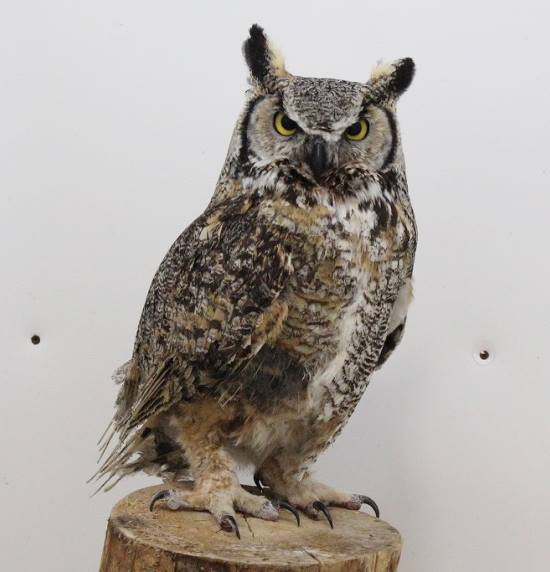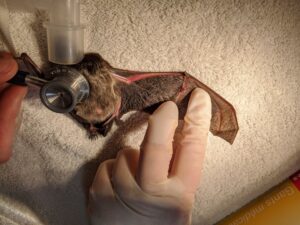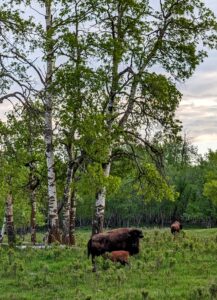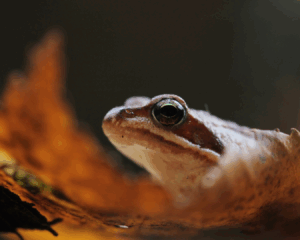Did you know that the Great Horned Owl is one of the most common owls in North America?
The Great Horned Owl is aptly named due to the tufts of feathers on the top of the head that appear to be horns or ears. In fact, the ears of this owl (and some other owls) are located on the side of the head and are asymmetric, meaning one is higher up than the other (Lewis 2016; Cornell University 2015). Ear asymmetry typically occurs with nocturnal owls because they rely on their hearing for hunting (Lewis 2016).
Another physiological adaptation that allows owls to hunt better at night is their unique disc-shaped face which helps funnel sound to their ears (IPT 2017; Lewis 2016; Cornell University 2015; FRGZEV 2006).
Although this species relies heavily on their hearing for hunting at night, the eyes of this predator are also adapted to be able to see in low light conditions which further aids their hunting abilities (IPT 2017; Cornell University 2015; FRGZEV 2006). The large size of the owl’s eyes allow them to absorb more light over the larger surface area (IPT 2017). They also contain a tapetum lucidum, which is an adaptation in many animals species that allows them to see better at night time and is the structure that causes eyes of some animals to “glow” at night when light is shined on them (IPT 2017).
The Great Horned Owl is one of the earlier nesting species in southern Alberta and often breed as early as late January or February. This species lays 2 to 3 eggs and both parents take turns incubating the eggs. The incubation period is 30 to 35 days, which means we can see hatchlings in our area as early as late February or early March. If one of the hatchlings falls out of the nest early, the parents will still care for him or her by feeding them on the ground (Cornell University 2015; FRGZEV 2006).
If you happen to see a young owl that has fallen out of it’s nest, make sure you observe to see if there are any parents nearby. If you think the nestling has been abandoned, please call AIWC for advice (403-946-2361).
AIWC currently has a Great Horned Owl patient who fell victim to a methane flare. This owl will remain with AIWC until she completes a full feather molt and can once again fly. If you would like to help with the care of this owl, please visit our Adopt an Animal page (https://www.aiwc.ca/support-us/adopt-an-animal/).
Interesting Great Horned Owl facts:
- The Long-eared owl is another species in Alberta who also has feather tufts that are often confused as horns or ears. Though, this species is much smaller than the Great Horned Owl.
- They use nests that were built by a different species (such as hawks, crows, ravens, herons, and even squirrels) (Cornell University 2015).
- The Great Horned Owl can weigh between .90 to just over 2.3 kilograms, with the female being larger than the male (Cornell University 2015; FRGZEV 2006).
- The Great Horned Owl can catch prey much larger than themselves and often preys upon ospreys, falcons and other owls. However, they mostly eat small mammals and birds (Cornell University 2015).
- The talons of this species are incredibly sharp, and hold on tightly to their prey. When clenched, the talons require a force of 13 kilograms to open them (Cornell University 2017).
- The Great Horned Owl uses their ear tufts to display how they are feeling. They stand upright when curious and lie flat when disgruntled (FRGZEV 2006).
- These owls are very stealthy. Their feathers offer camouflaging to the surrounding treed habitat and they are nearly silent when in flight (FRGZEV 2006).
- Many people believe that owls can turn their heads all the way around, when in fact, they can turn them 270 degrees. They are able to do this because of extra vertebra in their neck (FRGZEV 2006).
- Owl eyes don’t move in their sockets (Cornell University 2015).
- The call of the Great Horned Owl is one of the more recognizable owl calls and is a series of deep, stuttering hoots – usually 4 or 5 in a row (Cornell University 2015). To hear their call, visit this site: https://www.allaboutbirds.org/guide/Great_Horned_Owl/id
- Great Horned Owls stay all year long in Alberta and also live in South America (Cornell University 2015; FRGZEV 2006).
- (Cornell University 2015).
- The Great Horned Owl is a predator of crows and crows often attack, mob, and chase owls in the day time (Cornell University 2015).
By Tayler Hamilton, AIWC Volunteer
References:
Lewis, Deane. 2016. Owl Ears & Hearing. The Owl Pages. Available at: https://www.owlpages.com/owls/articles.php?a=6
Cornell University. 2015. Great Horned Owl. Available at: https://www.allaboutbirds.org/guide/Great_Horned_Owl
Friends of the Rosamond Gifford Zoo Education Volunteers (FRGZEV). 2006. Great Horned Owl. Available at: https://rosamondgiffordzoo.org/assets/uploads/animals/pdf/GreatHornedOwl.pdf
Idaho Public Television (IPT). 2017. Owls: Facts. Available at: https://idahoptv.org/sciencetrek/topics/owls/facts.cfm







6 thoughts on “The Great Horned Owl”
Hi! We have just purchased a small acerage to the east of Calgary. We were dismayed to find an owl carcass on the property but we have now seen what we are sure is a great horned owl sitting in our trees. How can we help and support this amazing bird? Thanks , Frances
Hello Frances,
Congratulations on your new home! It is sad to hear of the deceased owl you found, but there could have been many reasons for his/her passing. The best thing to do with the other owls in your area is just to give them space to live and thrive on their own. We would not advise any supplementary feeding or anything like that. If you have any other questions, please call us at 403-946-2361. Thank you!
does horned owls always hunt at night?
Yes, they do typically hunt at night but are known to hunt during the day in winter.
I have a family of owls 2 young ones in my yard. One has a lighter color than the other do males and females have a different coloring
Hi Bruce,
It’s not gender specific for colouring, but sizing is a good indicator once they are older. Typically, the females are larger than males.